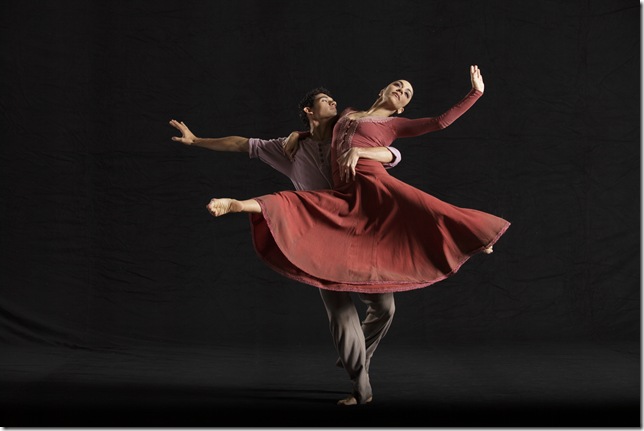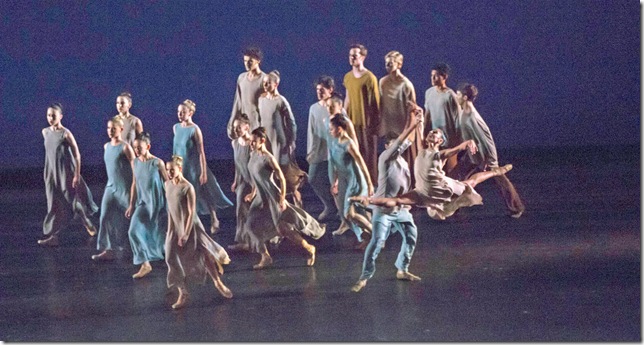By Tara Mitton Catao
Miami City Ballet took a big artistic bite out of some new repertoire in its second of four programs this season, and it paid off.
On Friday night at the Kravis Center, the Miami City Ballet dancers, ignited by an exciting range of music, danced with command and purpose in an aptly named program entitled See the Music. Revisiting old works and introducing new works of powerful dimensions, the dancers were brimming with energy.
It was an opportunity for the audience to re-explore older works with a new cast (and perhaps in a new light). Opening and closing the program were dances by Alexei Ratmansky and, of course, George Balanchine (there’s always at least one on the program). There also was the opportunity (and a rewarding one) to watch the dancers of the company as they dove head-first into the new movement of premiere works by Nacho Duato and Justin Peck.
The highlighted premiere of the evening was Jardí Tancat by Duato and rightly so, as it really showed the backbone of MCB. This beautiful first work of world-renowned Spanish-born choreographer Nacho Duato, created 30 years ago, is danced to Catalan folk music by six dancers. It has been an enormously successful work and has been set on numerous dance companies. But to set a great piece — even if it is on great dancers — doesn’t always guarantee that it will be a great success.
To do the earthbound, the barefooted movement in Jardí Tancat with its intricate gestures and rounded torso is a serious endeavor for every dancer, but even more so for a classically trained dancer no matter how talented he or she may be. Then, adding to the challenge of learning this new movement vocabulary, is performing it in a mixed repertory program. In one moment, the dancers have to completely change gears, shedding or donning pointe shoes so that moments later, they can dance in a ballet with a vocabulary that is fundamentally very different.
This is a risk-taking venture but one that the dancers seemed to relish. They took the challenge with verve and have expanded their artistic range by adding greater depth to their diversity of movement.
The women in this sextet, Jennifer Carlynn Kronenberg, Nathalia Arja and Tricia Albertson gave a more committed and developed performance than the men. Arja was particularly outstanding. Petite and dynamic, she captured not only the movement quality but also the essence of the work that portrayed the plain, hard life of farming peasants who rely on their hope and faith to keep them going. This a dance that has so much depth and texture that it will be a pleasure to see it done again by MCB as they continue to grow into and mature in the work.
Chutes and Ladders, a duet for seasoned company dancers Albertson and Renato Penteado and choreographed by Justin Peck, is a result of a new partnership with MCB and the New World Symphony. Created last year and performed in-the-round at the New World Center, Chutes and Ladders (named after the popular children’s board game) was re-worked for the proscenium stage in order for it to be presented Friday night as a preview of the young choreographer, a rising star at New York City Ballet who is slated to create a new full company work for MCB next season.
The choreographic premise is simple. A couple, simply costumed, dances on a bare stage to music performed onstage — in this case with a string quartet. It is the essence of dance; intimately responding to music by moving. The score, which is the first movement of Benjamin Britten’s String Quartet No. 1, oscillated between harmonious and agitated as does the choreography with its stops, starts and undertone nuances that were clearly inspired by the music.
Concerto Barocco nicely opened the program in a way that only the great master choreographer George Balanchine can do. Crisp and pure in look and presentation, it was choreographed to J.S. Bach’s Concerto for Two Violins. Guest artist Katia Carranza was especially captivating with her luscious movement and liquid lines which were full of breath and fluidity and accentuated by lovely footwork. She floated as she was solidly partnered by Carlos Miguel Guerra, and she shone as she danced juxtaposed to the very sprightly energy of the poised Sara Esty.
Closing the program was the large ensemble work Symphonic Dances, choreographed by Ratmansky and premiered just two years ago by MCB. It is a work that is visually vibrant with contrasting colors and Felliniesque characters swirling in a cacophony of movement and it is well worth re-experiencing.
Whether it was seeing different dancers who gave a different artistic touch to the lead roles or whether it was the influence of the See the Music theme of the night, it was a different experience. Letting Ratmansky’s conflicting images run unacknowledged and concentrating on listening to the music (which was excellently played and expertly conducted by Gary Sheldon), one could enjoy how the music drove the choreography and how the dancers’ movement embodied the music.
The Symphonic Dances (Op. 45), was composer Sergei Rachmaninov’s last composition, and it embodies the style of his final artistic stage. As music, choreography and dancers merged, this was exuberance on a grand scale.
The Miami City Ballet’s Program III includes Balanchine’s Episodes (Webern); Pas de Deux (Tchaikovsky), and Jerome Robbins’ West Side Story Suite, drawn from the Leonard Bernstein musical. It plays Feb. 14-Feb. 16 at the Adrienne Arsht Center, Miami; Feb. 21-Feb. 23 at the Broward Center, Fort Lauderdale, and Feb. 28-March 2 at the Kravis Center. The Miami City Ballet box office is reachable at 877-929-7010.


